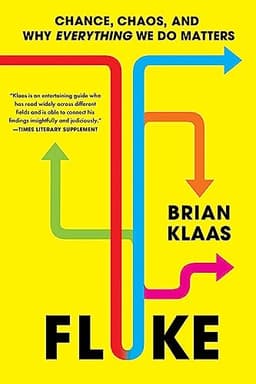
Fluke Book Summary
Chance, Chaos, and Why Everything We Do Matters
Book by Brian Klaas
Summary
In "Fluke," Brian Klaas argues that chance, chaos, and the interconnectedness of all things play a far greater role in shaping our lives and the world than we often acknowledge, and that embracing this insight can lead to a more meaningful and empowered existence.
Sign in to rate
Average Rating: 3.8
The Pivotal Vacation That Shaped History
In 1926, Mr. and Mrs. H. L. Stimson vacationed in Kyoto, Japan. Nineteen years later, Stimson, as U.S. Secretary of War, used his fond memories of Kyoto to ensure it was removed from the list of potential atomic bomb targets.
Instead, Hiroshima and Nagasaki were bombed, with the latter only being targeted due to unexpected cloud cover over the original target of Kokura. The Stimsons' seemingly innocuous vacation ended up sparing one hundred thousand lives in Kyoto while sealing the fate of a similar number elsewhere, demonstrating the immense impact small, chance events can have.
Section: 1, Chapter: 1
Laplace's Demon And The Limits Of Prediction
Laplace proposed a thought experiment involving an omniscient being (Laplace's demon) that could know the precise details of every atom in the universe. With such perfect information, Laplace argued, this being could predict the future with absolute certainty.
However, chaos theory, as discovered by Edward Norton Lorenz, shows that even in deterministic systems, microscopic differences in initial conditions can lead to vastly different outcomes over time. This means that even if Laplace's demon existed, the tiniest measurement error would cause its predictions to become wildly inaccurate. Perfect prediction is therefore impossible, highlighting the fundamental uncertainty and unpredictability of our world.
Section: 1, Chapter: 1
The Delusion Of Individualism In An Intertwined World
We tend to view our lives through an individualist prism, imagining that we are in control of our destinies and that our major decisions define our path. However, the reality is that we live in a deeply intertwined world where the decisions and actions of others, even those we will never meet, can profoundly shape our lives in ways we often fail to perceive.
The delusion of individualism blinds us to the complex web of causality that connects us all across time and space. Recognizing the relational, intertwined nature of existence is crucial for understanding how change truly happens in our lives and societies.
Section: 1, Chapter: 2
Ivan's Lifesaving Soccer Ball
In the summer of 2022, a tourist named Ivan was swept out to sea off the coast of Greece. Just before slipping under the waves, he spotted a soccer ball floating in the distance and swam to it, clinging to it until he was rescued 18 hours later. It turned out the ball had drifted 80 miles after two boys accidentally kicked it into the sea 10 days earlier. Without their inadvertent action, Ivan would have perished. This story powerfully illustrates how even the seemingly insignificant choices of people we will never meet can become inextricably linked with our own fates in an intertwined world.
Section: 1, Chapter: 2
The Illusion of Individualism
"The real story of our lives is often written in the margins. Small details matter, and even the apparently insignificant choices of people we will never meet can seal our own fates—though most of us will never see that quite so clearly as Ivan did."
Section: 1, Chapter: 2
The Greatest Fluke Of All Time
Around 2 billion years ago, a single bacterium bumped into a prokaryotic cell and ended up inside it. That bacterium eventually evolved into a mitochondrion, the powerhouse of our cells. This chance event, which occurred just once and never again, enabled the rise of all complex life on Earth, from plants to animals to humans.
Our very existence can be traced back to this microscopic accident, underscoring the immense role of contingency and chance in shaping the history of life.
Section: 1, Chapter: 3
Survival Of The Luckiest
The popular conception of evolution emphasizes "survival of the fittest," suggesting a relentless optimization process. However, Stephen Jay Gould and other scientists have shown that chance and contingency play a much larger role. Humanity's evolutionary history is marked by flukes:
- The rise of mammals was enabled by the chance asteroid impact that wiped out the dinosaurs.
- Genetic bottlenecks and founder effects meant that the composition of small, arbitrarily selected populations ended up shaping the future of our species.
- Recent research suggests our intellect may have developed to cope with chaotic climate fluctuations in the Rift Valley.
Recognizing the role of randomness and chance in our origins is crucial for understanding the contingent nature of our existence.
Section: 1, Chapter: 3
Bacteria Evolve In Real-Time, Demonstrating Contingency
Richard Lenski's Long-Term Evolution Experiment (LTEE) has tracked the evolution of E. coli bacteria through over 70,000 generations. Twelve initially identical populations are grown in separate flasks, allowing researchers to observe evolutionary changes and test for the role of contingency.
A key finding emerged when one population suddenly gained the ability to metabolize citrate due to a series of specific, unlikely mutations. Despite "replaying the tape" many times, this ability never re-evolved, powerfully demonstrating the role of contingency in shaping evolutionary outcomes. The LTEE shows that while evolution may seem convergent and predictable over short timescales, history can pivot on chance events.
Section: 1, Chapter: 3
The Fitness Beats Truth Theorem
Our perceptions of reality have been shaped by evolution to be useful for our survival, not to accurately reflect the truth. The Fitness Beats Truth theorem, developed by evolutionary biologists and cognitive scientists, shows that natural selection will always favor perceptual strategies that enhance reproductive fitness over those that provide a more truthful representation of the world.
Just as a computer's desktop interface is a useful but inaccurate depiction of the machine's actual workings, our brains present us with a simplified, sometimes illusory model of reality that nonetheless enables us to effectively navigate our environment. Recognizing that our perceptions are inherently biased and limited is crucial for understanding how we make sense of the world.
Section: 1, Chapter: 4
Sea Turtles And Jewel Beetles - When Shortcuts Fail
Evolutionary "shortcuts" in cognition can lead organisms astray when their environment changes in unexpected ways:
- Sea turtle hatchlings instinctively move towards the brightest part of the horizon, which under natural conditions leads them to the ocean. However, with the advent of beachfront development, artificial lighting has caused many hatchlings to move away from the water, perishing in droves.
- Male jewel beetles are wired to attempt to mate with females that have a distinct size, color, and dimpled texture. When a beer company unknowingly mimicked these traits on their bottles, male beetles began fruitlessly trying to copulate with discarded bottles, neglecting actual females.
Section: 1, Chapter: 4
The Paradox Of The Locust Swarm
Locust swarms demonstrate a perplexing dynamic that mirrors aspects of modern human society. At low densities, locusts behave as individuals, their actions uncoupled from those around them. At medium densities, they form semi-coordinated clusters, but these clusters are prone to sudden directional changes and function independently of one another.
However, at high densities, locusts undergo a behavioral phase shift, coalescing into a unified swarm that moves together. Surprisingly, despite the swarm's coordinated movement, the overall direction of the swarm is highly unpredictable and can shift abruptly based on slight perturbations. This "paradox of the swarm" - the coexistence of individual order and collective unpredictability - characterizes many modern human systems and helps explain our vulnerability to sudden crises.
Section: 1, Chapter: 5
Self-Organized Criticality And The Edge Of Chaos
Many complex systems, both natural and human, exhibit self-organized criticality, a concept developed by Per Bak. These systems:
- Evolve to a critical state poised at the "edge of chaos" through gradual changes.
- Maintain a self-organized equilibrium despite small perturbations.
- Eventually experience sudden, catastrophic collapses when a tipping point is reached.
Bak's sandpile model illustrates the dynamics: grains of sand are slowly added to a pile, building up in a predictable manner until one grain triggers a massive avalanche. Similarly, human systems like economies or political institutions can appear stable as stresses gradually mount, but they are increasingly vulnerable to total disruption from a small shock. Recognizing self-organized criticality is vital for understanding systemic risk in an interconnected world.
Section: 1, Chapter: 5
Knightian Uncertainty Versus Risk
The economist Frank Knight distinguished between two types of unknowns:
- Risk refers to situations where the range of possible outcomes is known, and their probabilities can be estimated (e.g., rolling a six-sided die).
- Uncertainty (or "Knightian uncertainty") refers to situations where the possible outcomes and their likelihoods are both unknown and unknowable (e.g., the impact of a fundamentally new technology).
In an increasingly complex, rapidly changing world, more of our key challenges fall into the domain of uncertainty rather than risk. Treating uncertain situations as if they were merely risky - attempting to estimate probabilities and outcomes based on past data - can lead to dangerous miscalculations and fragility. Recognizing the limits of probabilistic reasoning in the face of radical uncertainty is essential for navigating the modern age.
Section: 1, Chapter: 6
The Land Of Heraclitean Uncertainty
In stable, slowly changing environments, past patterns can serve as reliable guides to the future. This is the "Land of Stationary Probabilities," where forecasting approaches like Nate Silver's election models work well. However, in complex, rapidly shifting contexts, the underlying rules can change abruptly, rendering historical data and models obsolete. This is the "Land of Heraclitean Uncertainty," which include such characteristics:
- Non-stationarity: The mechanisms generating outcomes vary over time.
- Non-ergodicity: Specific outcomes matter more than long-run averages.
- Non-repeatability: Situations are unique and not easily comparable to past examples.
- Contingency: Small, random factors can dramatically swing end results.
Attempting to use probabilistic methods in the Land of Heraclitean Uncertainty is akin to navigating a churning sea with a map of a still lake. Recognizing when we are in the realm of radical uncertainty rather than calculable risk is vital for effective decision-making.
Section: 1, Chapter: 6
Narratives Drive Action and Change History
The power of stories to shape outcomes is demonstrated by the 2004 Indian Ocean tsunami. An indigenous population called the Moken heeded ancient legends about a "laboon" or "wave that eats people," which described key warning signs - the ocean receding, the cicadas going silent. Guided by this narrative, the Moken fled to higher ground when those signs appeared, surviving the catastrophic tsunami without a single casualty. Their neighbors, lacking this story, perished in vast numbers.
Similarly, economists like Robert Shiller argue that compelling narratives, not just quantitative data, drive trends like economic booms and busts or the abolition of slavery. While we like to imagine that the world runs on cold equations, it's the stories we tell that often determine our collective behavior - and therefore how history unfolds. Harnessing the power of narratives is crucial for driving positive change.
Section: 1, Chapter: 7
The Baby Hitler Dilemma
The perennial question "If you could go back in time and kill baby Hitler, would you?" seems like a straightforward ethical dilemma, but it actually hinges on our theories about how change happens in human society. Those who believe that individual leaders (like Hitler) are the prime movers of history are more likely to view such an act as justified or even necessary.
But those who see larger structural forces and broad social dynamics as the true drivers of change will be warier, as they doubt that removing one actor, even an influential one, would dramatically alter the overall trajectory. When faced with a complex social problem, we must thoughtfully examine our mental models of how the world works - and consider alternative perspectives - before rushing to drastic action, lest we make the situation worse.
Section: 1, Chapter: 7
How Phytoplankton From Dinosaur Era Affected 2020 US Election
During the Cretaceous period, an inland sea covered much of the southern US. The deaths of trillions of phytoplankton in this sea created nutrient-rich soil in a region that would become known as the Black Belt. Millions of years later, in the 1800s, enslaved Africans toiled on cotton plantations on this fertile crescent. After the Civil War, their descendants remained in the area due to social and economic factors.
Fast-forward to 2020: Black voters (who overwhelmingly vote Democrat) turned out in high numbers in Georgia's Black Belt region, narrowly swinging the state to Biden and handing Democrats control of the Senate. The political trajectories of Georgia and the US hinged on the exact locations of microscopic marine organisms when dinosaurs roamed the earth, illustrating the astonishing concatenation of geographic and human factors across vast timescales that shape historical outcomes.
Section: 1, Chapter: 8
Human Space-Time Contingency - Oil Wealth and Power
The concept of human space-time contingency highlights how the impact of geographical factors on human societies varies dramatically based on the specific social and technological context. Saudi Arabia provides a prime example:
- Oil deposits formed in the region 160 million years ago, but were only discovered in 1938.
- At that time, Saudi Arabia was among the poorest countries, with limited use of modern technology.
- The internal combustion engine and 20th-century industrialization abruptly made these oil reserves immensely valuable.
- Within a few decades, Saudi Arabia became one of the richest and most powerful nations.
This rapid reversal of fortunes wasn't determined solely by geography or human factors, but by their interaction at a specific juncture.
Section: 1, Chapter: 8
The Ghosts of Geography
"Geography, it is sometimes said, is destiny. That's hyperbole, a statement that erases humans as authors of their own histories. But geography does provide the folio within which we write, as our lives are shaped and diverted by the physical environment."
Section: 1, Chapter: 8
The Role Of Chance In Conception And Existence
Each human life is the product of a remarkable chain of unlikely events. The exact timing of conception, dependent on innumerable chance factors, determines which specific sperm fertilizes the egg. Any slight deviation in this process would result in a genetically distinct individual.
Moreover, for any given person to exist, a particular lineage of ancestors had to survive and reproduce, going back innumerable generations. Even a single break in this chain would mean the person would never have been born, replaced by a different possible descendant. Recognizing the sheer contingency involved in each person's existence can foster a profound sense of the preciousness and unlikelihood of every life.
Section: 1, Chapter: 9
The Ripple Effects of Every Life
"You matter, down to the littlest, most insignificant decisions you have made or will ever make. Your words, your actions, even your thoughts and feelings, will have ripple effects that emanate widely, beyond what you'll ever see or realize, even well beyond your lifetime."
Section: 1, Chapter: 9
How Arbitrary Timekeeping Shapes Modern Life
Our lives are regulated by timekeeping systems that are the product of chance historical developments, not neutral, objective features of the natural world:
- The 7-day week has no astronomical basis, but derives from ancient Babylon, the Bible, and the Romans happening to see 7 celestial bodies.
- Month lengths and the irregular placement of leap days are a kludgy attempt to reconcile lunar and solar cycles.
- The start and length of years and eras vary across societies, shaped by cultural and religious traditions.
Yet these arbitrary constructs dictate the rhythms of our lives, from work schedules to holiday celebrations to financial cycles. Recognizing the contingent roots of our shared temporal framework can highlight how much of what we take for granted as fixed or inevitable is the result of happenstance and ancient choices, not immutable law.
Section: 1, Chapter: 10
Momentous Events Shaped By Precise Timing
The stories of Joseph Lott and Elaine Greenberg illustrate how tiny shifts in timing can have life-altering consequences:
- Lott survived 9/11 because he went back to his hotel room to change shirts after receiving a Monet tie that clashed with the one he was wearing. The delay meant he wasn't in the World Trade Center when it was attacked.
- Greenberg, who gave Lott the tie, died in the attack because she had taken her vacation a week earlier than originally planned.
If Lott had decided to keep his original shirt, he likely would have died. If Greenberg had kept her original vacation dates, she would have lived. These outcomes hinged on the precise sequence and timing of small choices and chance events, highlighting the often razor-thin and arbitrary line between life and death, triumph and tragedy.
Section: 1, Chapter: 10
The Peril of P-Hacking in Social Science Research
P-hacking, or manipulating data analysis to achieve statistically significant results, is a major problem in academic research. It can lead to the publication of spurious findings and distort our understanding of the world. Key issues:
- Researchers often face strong incentives to "torture the data" until they get p-values under 0.05 (the usual publication threshold).
- Analytical flexibility allows many "forking paths" to significant results, even if the underlying effect is negligible or nonexistent.
- Publication bias means p-hacked studies get published while negative results languish in file drawers, skewing the record.
Solutions like pre-registration of analysis plans and emphasizing effect sizes over statistical significance are gaining traction. But the deeper issue is a flawed model of "one-shot" science that fetishizes single, surprising results over repeated, incremental progress.
Section: 1, Chapter: 11
The Hard Problem Of Social Science
Even when technical issues like p-hacking are addressed, social science faces a "Hard Problem" that stems from the radical uncertainty of the social world:
- Equifinality: Many models can fit the same data, so drawing firm conclusions is difficult.
- Reflexivity: Studying social phenomena can alter their dynamics, invalidating models.
- Causal density: Outcomes arise from complex, ever-shifting interactions, not isolatable variables.
- Knightian uncertainty: The range of possible futures is often unknowable, rendering precise probability estimates meaningless.
Section: 1, Chapter: 11
Embracing Determinism As Awe-Inspiring, Not Demoralizing
The possibility that our lives and choices are the product of prior causes, not autonomous free will, is often seen as depressing. But this deterministic picture can be reframed in an inspiring way:
- Our lives are part of an unbroken causal chain extending back to the Big Bang. Every decision by every human has shaped what is possible now.
- Small choices by our distant ancestors, lovingly making their way through life, were necessary links in the chain that led to our existence.
- When we make positive choices, we play a role in enabling goodness and beauty to reverberate down through the generations.
From this angle, determinism is a reminder of our profound interdependence and the way our lives are inextricably bound up with the whole of history.
Section: 1, Chapter: 12
Punishment And Rehabilitation In A World Without Free Will
If our choices are shaped by factors beyond our control, can we justify punishing wrongdoers? A deterministic view requires rethinking, but need not abolish, criminal justice:
- Retributive rationales for punishment are undermined, as offenders are seen as unfortunate, not inherently evil.
- Consequentialist rationales - deterrence, incapacitation, rehabilitation - still hold, as they don't require metaphysical free will.
- Punishment of some sort remains necessary to shape behavior and protect society, even if offenders aren't ultimately "blameworthy."
- The priority shifts from making offenders "pay" to changing the conditions that drive crime in the first place.
Just as we separate dangerous but "innocent" people like violent Alzheimer's patients without moral condemnation, a deterministic criminal justice system would aim at preventing harm and maximizing flourishing, not meting out just deserts.
Section: 1, Chapter: 12
The Explore/Exploit Tradeoff In An Uncertain World
In complex, shifting environments, success requires balancing two strategies:
- Exploration: Seeking out new possibilities and gathering information, even without immediate payoff.
- Exploitation: Focusing efforts on leveraging existing knowledge to maximize current performance.
Explore too little and you may miss out on major opportunities. Exploit too soon and you may get stuck in obsolete practices. Key principles:
- Maintain a diverse portfolio of options, hedging against shocks to any one area.
- Embrace "risk" as providing valuable information, not just danger.
- Shift from exploitation to exploration as uncertainty and change accelerate.
- Use randomized experimentation to find unexpected bright spots when old models break down.
Section: 1, Chapter: 13
This concept is also discussed in:
Algorithms To Live By
The Awe of Interconnection
"When we try to pick out anything by itself," the naturalist John Muir once said, "we find it hitched to everything else in the Universe." We are each hitched to one another, which yields a profound gift: that everything we do matters, including whatever you decide to do now, when you close this book, and go out to explore that wonderful, maddening, infinitely complex world that we call home."
Section: 1, Chapter: 13
Related Content
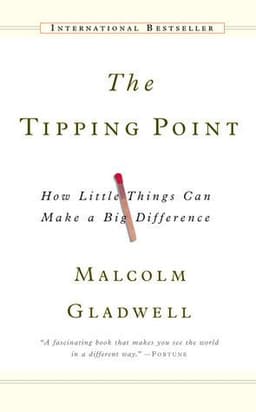
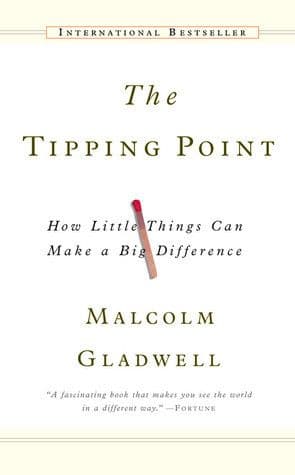
The Tipping Point Book Summary
Malcolm Gladwell
The Tipping Point reveals the hidden forces that cause social epidemics - from fashion trends to crime waves - to spread like viruses, and shows how to start and control positive epidemics of our own.
The Tipping Point reveals the hidden forces that cause social epidemics - from fashion trends to crime waves - to spread like viruses, and shows how to start and control positive epidemics of our own.
Psychology
Personal Development
Sociology
Economics
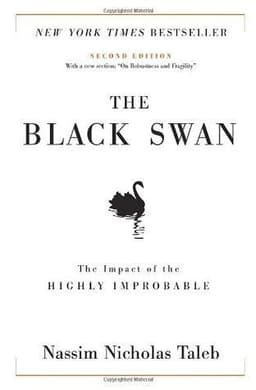
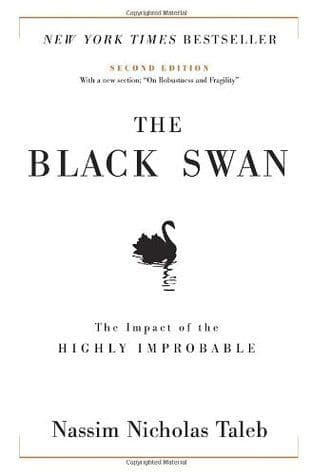
The Black Swan Book Summary
Nassim Nicholas Taleb
The Black Swan is about the extreme impact of rare and unpredictable outlier events, and how we tend to find simplistic explanations for them after the fact, making us blind to randomness and vulnerable to future Black Swans.
The Black Swan is about the extreme impact of rare and unpredictable outlier events, and how we tend to find simplistic explanations for them after the fact, making us blind to randomness and vulnerable to future Black Swans.
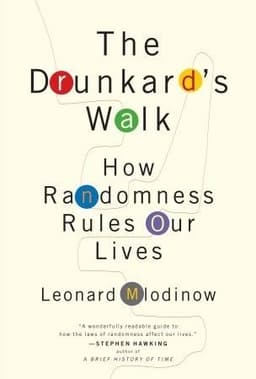
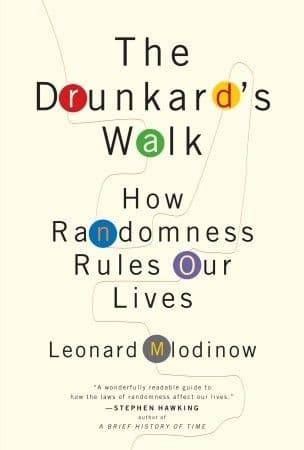
The Drunkard's Walk Book Summary
Leonard Mlodinow
"The Drunkard's Walk" reveals how randomness and chance play a far greater role in our lives than we typically realize, challenging our perceptions of success, decision-making, and the patterns we think we see in the world around us.
"The Drunkard's Walk" reveals how randomness and chance play a far greater role in our lives than we typically realize, challenging our perceptions of success, decision-making, and the patterns we think we see in the world around us.
Psychology
Economics
Statistics
Heuristics

